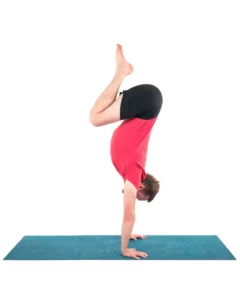Strengthen Your Legs and Improve Your Balance with These 2 Warrior III Pose Modifications

Adapting Your Yoga Practice Over Time
The way we practice yoga changes with time. It’s wise to understand this. Otherwise, we might get caught up thinking it should be the same as when we first began, or at least the same as yesterday. We may be disappointed when we cannot practice as usual while healing from an injury. Or we may worry that we won’t ever return to our yoga mat when tending to a loved one who’s ill. But being a yoga student makes us increasingly aware that everything changes. Situations arise that demand an adjustment to the way we practice. This is where modifications come in. Modifying poses is an expression of wisdom and compassion. This post will explore Warrior III modifications to strengthen your legs and improve your balance.
Recovering from Quadriceps Tendon Surgery: A Journey
For example, I had a quadriceps tendon repair surgery three months ago. Post-op, I wore an immobilizer knee brace for six weeks. The brace kept my leg straight at the knee all day and all night (well, mostly all night, but I sometimes awakened with the brace magically off). Six weeks of immobility left my leg’s mobility and strength diminished. I had no choice but to relax into the situation. I needed the brace’s support while my tendon fibers healed. I needed to do my exercises. And I needed to rest.
As my healing progressed, my knee was initially allowed a 15-degree bend. Two weeks later, another 15 degrees, and so on. My physical therapist manually adjusted the brace to accommodate my incrementally increasing capacity for flexion. The brace protected me from bending too deep in potential falls or knee-jerk responses in my physical therapy and my daily activities.
The Importance of Modifications in Yoga
As I began to add standing poses to my protocol, I particularly appreciated these two modified/propped approaches to Warrior III Pose (Virabhadrasana III).
I use these poses to rebuild strength. I am up to the challenge of redeveloping my balance and proprioception. Now that I am strong enough to stabilize from the inside, I have finally cast the brace aside.
Warrior III Pose Modification #1: How to Practice a Warrior III Pose Flow with a Chair for Balance and Strength

- Place a chair’s back legs on the front end of your mat so it stays put.
- Stand in Mountain Pose (Tadasana), with legs close together, facing the back of the chair.
- Stand near the chair, lightly touching its backrest with your fingertips. The chair (or a kitchen sink, railing, or wall) is helpful for balance.
- Shift onto one foot. Feel the muscles of your thigh and outer hip firm and tighten as you bear weight through your leg.
- Bend your leg toward your chest, keeping your fingertips touching the backrest as needed to move into Stork Pose.
- Keep part of your attention on your stable, standing leg as you shift your torso and tilt your pelvis. Extend and straighten your moving leg into Warrior III Pose, increasing the challenge to your standing leg’s stability and balance.
- Take a moment before you raise the trunk upright and transition into the Stork Pose again.
- Repeat twice more. Feel how shifting your weight from front to back (Stork Pose to Warrior III) challenges the muscles of your leg and core and your balance.
- Return to Mountain Pose.
- Pause. Switch sides.
Practice Tips for Warrior III Flow with a Chair
- Breathe naturally and gently.
- If you are used to holding static poses, welcome the novelty of flowing with your breath and challenging your stability as you move. Through repetition, you will gain confidence and flow more easily.
- You can use the chair to help you keep your balance. Balance comes best when we relax about balancing. It’s not something we do once; striking a balance is something we do repeatedly.
- Feel free to have your hands in a Prayer Pose (Anjali Mudra) as your balance and strength improve, letting go of the chair.
- Rather than locking the knee of your standing leg, soften at the joint to encourage muscular effort rather than “hanging on your joints.” This effort will bring more blood and healing prana (energy) to the muscles.
Warrior III Pose Modification #2: Use a Table to Support Your Trunk And Tone Your Hips and Legs
This Warrior lll variation removes the weight-bearing and balancing aspects of the pose, allowing the focus to shift to the muscle activation of your legs. As Alison West of Yoga Union (NYC) writes, “Taking the shape of a pose without the full effort, or what I call the Savasana of the pose, can bring understanding and clarity as well as emotional well-being.”
- Choose a stable table (a massage table, a dining room table, or a countertop).
- Assess its height compared to the length of your legs. Ideally, the tabletop is approximately the height of your hip creases (where the hip joint flexes).
- Stand in Mountain Pose with your legs or feet together, with the fronts of your legs near the table.
- Tip your trunk forward over your thighs. Land your trunk on the table (or a pile of folded firm blankets).
- Rest your forehead on your folded arms or stacked palms.
- Adjust your feet to align your legs perpendicular to the floor.
- Let the table hold your weight and support you. You can release any effort to balance now.
- Breathe gently. Stay a while. Let your back spread and relax.
- Press your footprints into the floor and lift your arches.
- Hug your thigh muscles to the bone and lift them toward your pelvis. Be gentle with this firming since you have the table to support most of your weight.
- As you exhale, shift your weight onto one foot. Lift the other leg behind you, keeping your knee and foot pointing towards the floor.
- Aim to raise the leg parallel to the floor, aligning with your torso.
- Point (plantar flexion) your raised foot while you flex and spread your toes. This dynamic combination can increase neuromuscular activation, improve balance, and develop proprioception. Or, flex (dorsiflexion) the raised foot and spread your toes to increase glute engagement and stabilize the pelvis.
- Hold the pose and breathe smoothly.
- Mindfully release the leg to join the standing leg.
- Switch legs.
Practice Tips for Supported Warrior III Pose on a Table

- Use a couple of yoga blocks to raise the floor under your feet if the table is too high. Arrange the blocks together at their lowest height, like an equal sign. Stand so your heels are on one block and the balls of your feet on the other.
- If the table is too low, stack however many neatly folded blankets you need on the tabletop to lift it to meet your trunk.
- Reaching the table or the blanket stack should be effortless. Take care to set yourself and your props up well.
- If the blankets are compressing your belly, step back a few inches to give it space, or move the blankets forward a few inches.
- After a few breaths, if your table is long enough, lift your head and watch as you stretch your arms forward and join the palms together to establish a stretch of the whole front of your body.
- If the stretch in the back of the standing knee is the primary sensation, you may be locking at the knee joint or hyperextending the knee. To soften there, shift some weight into the ball of your foot. Lift the kneecap instead of pushing it back into the joint.
The Wisdom of Adapting Your Yoga Practice
Adapting your practice to meet your current needs is a sign of wisdom in yoga. Whether recovering from an injury or surgery or interested in new ways to engage with familiar poses, these Warrior III modifications can offer meaningful benefits.
Using props like a chair or a table allows you to focus more on strengthening your legs and hips because you don’t have to work as hard to maintain your balance. When your legs and hips are strong, your back and spine will be well supported. This support makes balance and movement more fluid and controlled, keeping you and your joints safe as you practice.
Try these variations as part of your practice this week. You may be surprised how simple approaches to a challenging pose can create strength and ease and reveal a fresh perspective.
Also, read...
Teaching Svadhyaya: 3 Ways to Encourage Self-Study in Yoga
In Celebration of Gray-Haired Yoga – Busting the Myth of the Yoga Body
Related courses

Sarah Bell (ERYT-500, YACEP) has been teaching yoga since 1994. She was on the faculty of the Yoga Works Teacher Training Program for fifteen years, having trained hundreds of teachers in both the 200-hour Introductory Courses and the 300-hour Professional Programs throughout the country and abroad. She is the creator of Speaking of Yoga, a voice and communication course for yoga teachers, as well as Beyond the Postures, a course that introduces yoga philosophy, anatomy, pranayama, and meditation to curious yoga practitioners. She mentors yoga teachers along the path as they find their voice and refine their skills. For more information on her upcoming retreats, courses, and classes, find her at www.sarahbellyoga.com






